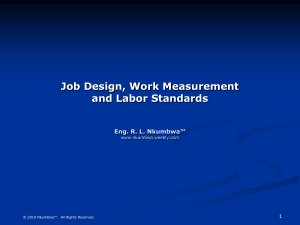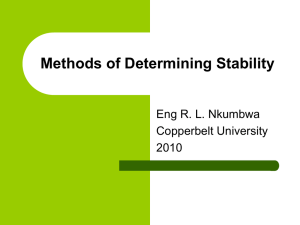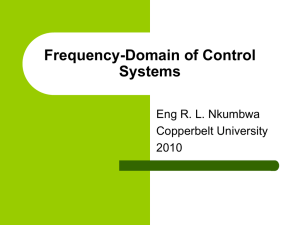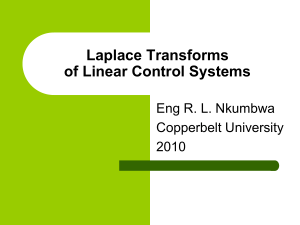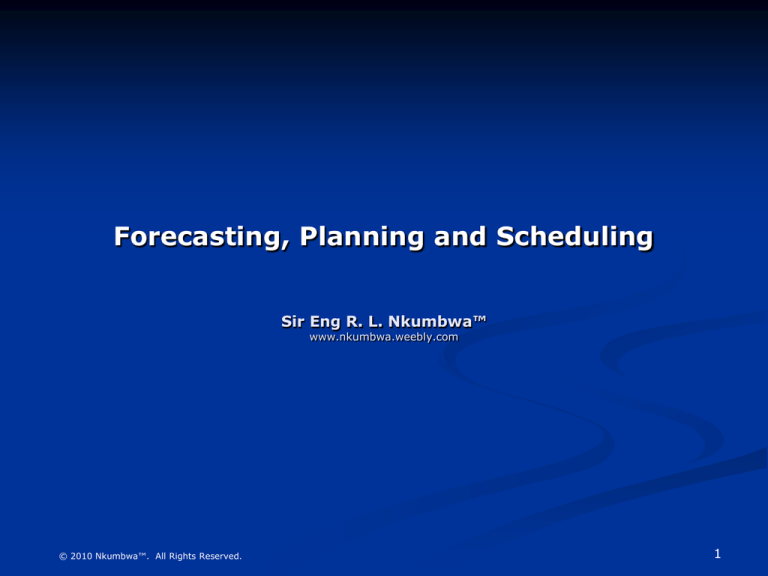
Forecasting, Planning and Scheduling
Sir Eng R. L. Nkumbwa™
www.nkumbwa.weebly.com
© 2010 Nkumbwa™. All Rights Reserved.
1
Outline
Forecasting
Production Planning
Production Scheduling
Material Resource Planning (MRP)
Enterprise Resource Planning (ERP)
© 2010 Nkumbwa™. All Rights Reserved.
2
Forecasting
© 2010 Nkumbwa™. All Rights Reserved.
3
Forecasting Approaches
Time Series Forecasting
Methods
Monitoring and Control
Other Sectors
© 2010 Nkumbwa™. All Rights Reserved.
4
What is Forecasting?
Educated Guessing
Process of predicting a future event
Underlying basis of all business decisions
Production
Inventory
Personnel
Facilities
© 2010 Nkumbwa™. All Rights Reserved.
5
Types of Forecasts by Time Horizon
Short-range forecast
Up to 1 year; usually less than 3 months
Job scheduling, worker assignments
Medium-range forecast
3 months to 3 years
Sales & production planning, budgeting
Long-range forecast
3+ years
New product planning, facility location
© 2010 Nkumbwa™. All Rights Reserved.
6
Short-term vs. Longer-term Forecasting
Medium/long range forecasts deal with more
comprehensive issues and support management
decisions regarding planning and products, plants and
processes.
Short-term forecasting usually employs different
methodologies than longer-term forecasting
Short-term forecasts tend to be more accurate than
longer-term forecasts.
© 2010 Nkumbwa™. All Rights Reserved.
7
Influence of Product Life Cycle
Introduction, Growth, Maturity, Decline
Stages of introduction and growth require longer forecasts
than maturity and decline
Forecasts useful in projecting
staffing levels,
inventory levels, and
factory capacity
as product passes through life cycle stages
© 2010 Nkumbwa™. All Rights Reserved.
8
Strategy and Issues During a Product’s
Life
Company Strategy/Issues
Introduction
Growth
Best period to increase
market share
Practical to change price or
quality image
R&D product
engineering critical
Strengthen niche
Maturity
Poor time to change image,
price, or quality
Competitive costs become
critical
Decline
Cost control
critical
Defend market position
Fax machines
Drive-thru restaurants
CD-ROM
3 1/2” Floppy
disks
Sales
Color copiers
Station
wagons
Internet
OM Strategy/Issues
HDTV
Product design and development
critical
Forecasting critical
Standardization
Little product differentiation
Product and process reliability
Frequent product and process
design changes
Cost minimization
Competitive product
improvements and options
Less rapid product changes more minor changes
Short production runs
Increase capacity
High production costs
Shift toward product focused
Limited models
Enhance distribution
Attention to quality
© 2010 Nkumbwa™. All Rights Reserved.
Optimum capacity
Increasing stability of process
Long production runs
Product improvement and
cost cutting
Over capacity in the industry
Prune line to eliminate items
not returning good margin
Reduce capacity
9
Types of Forecasts
Economic forecasts
Address business cycle, e.g., inflation rate, money
supply etc.
Technological forecasts
Predict rate of technological progress
Predict acceptance of new product
Demand forecasts
Predict sales of existing product
© 2010 Nkumbwa™. All Rights Reserved.
10
Seven Steps in Forecasting
Determine the use of the forecast
Select the items to be forecasted
Determine the time horizon of the forecast
Select the forecasting model(s)
Gather the data
Make the forecast
Validate and implement results
© 2010 Nkumbwa™. All Rights Reserved.
11
Product Demand Charted over 4 Years with
Trend and Seasonality
Demand for product or service
Seasonal peaks
Trend component
Actual
demand line
Random
variation
Year
1
© 2010 Nkumbwa™. All Rights Reserved.
Year
2
Average demand
over four years
Year
3
Year
4
12
Actual Demand, Moving Average, Weighted
Moving Average
35
Sales Demand
30
25
Weighted moving average
Actual sales
20
15
10
Moving average
5
0
Jan Feb Mar Apr May Jun Jul Aug Sep Oct Nov Dec
Month
© 2010 Nkumbwa™. All Rights Reserved.
13
Realities of Forecasting
Forecasts are seldom perfect
Most forecasting methods assume that there is some
underlying stability in the system
Both product family and aggregated product forecasts
are more accurate than individual product forecasts
© 2010 Nkumbwa™. All Rights Reserved.
14
Forecasting Approaches
Qualitative Methods
Used when situation is vague
& little data exist
New products
New technology
Involves intuition, experience
e.g., forecasting sales on
Internet
© 2010 Nkumbwa™. All Rights Reserved.
Quantitative Methods
Used when situation is
‘stable’ & historical data exist
Existing products
Current technology
Involves mathematical
techniques
e.g., forecasting sales of
color televisions
15
Overview of Qualitative Methods
Jury of executive opinion
Delphi method
Panel of experts, queried iteratively
Sales force composite
Pool opinions of high-level executives, sometimes
augment by statistical models
Estimates from individual salespersons are reviewed for
reasonableness, then aggregated
Consumer Market Survey
Ask the customer
© 2010 Nkumbwa™. All Rights Reserved.
16
Jury of Executive Opinion
Involves small group of high-level managers
Group estimates demand by working together
Combines managerial experience with statistical models
Relatively quick
‘Group-think’
disadvantage
© 2010 Nkumbwa™. All Rights Reserved.
17
Sales Force Composite
Each salesperson projects his
or her sales
Combined at district & national
levels
Sales reps know customers’
wants
Tends to be overly optimistic
© 2010 Nkumbwa™. All Rights Reserved.
18
Delphi Method
Iterative group process
3 types of people
Decision makers
Staff
Respondents
Reduces ‘group-think’
Decision Makers
Staff
(What will
(Sales?)
(Sales will be 50!)
sales be?
survey)
Respondents
(Sales will be 45, 50, 55)
© 2010 Nkumbwa™. All Rights Reserved.
19
Consumer Market Survey
Ask customers about
purchasing plans
What consumers say,
and what they actually
do are often different
Sometimes difficult to
answer
© 2010 Nkumbwa™. All Rights Reserved.
20
Quantitative Forecasting Methods
(Non-Naive)
Quantitative
Forecasting
Associative
Models
Time Series
Models
Moving
Average
Exponential
Smoothing
© 2010 Nkumbwa™. All Rights Reserved.
Trend
Projection
Linear
Regression
21
What is a Time Series?
Set of evenly spaced numerical data
Obtained by observing response variable at regular time
periods
Forecast based only on past values
Assumes that factors influencing past and present will
continue influence in future
Example
Year:
Sales:
© 2010 Nkumbwa™. All Rights Reserved.
1998
78.7
1999
63.5
2000
89.7
2001
93.2
2002
92.1
22
Time Series Components
Trend
Cyclical
Seasonal
Random
© 2010 Nkumbwa™. All Rights Reserved.
23
Trend Component
Persistent, overall upward or downward pattern
Due to population, technology etc.
Several years duration
© 2010 Nkumbwa™. All Rights Reserved.
24
Seasonal Component
Regular pattern of up & down fluctuations
Due to weather, customs etc.
Occurs within 1 year
© 2010 Nkumbwa™. All Rights Reserved.
25
Cyclical Component
Repeating up & down movements
Due to interactions of factors influencing economy
Usually 2-10 years duration
© 2010 Nkumbwa™. All Rights Reserved.
26
Random Component
Erratic, unsystematic, ‘residual’ fluctuations
Due to random variation or unforeseen events
Union strike
Tornado
Short duration &
nonrepeating
© 2010 Nkumbwa™. All Rights Reserved.
27
Naive Approach
Assumes demand in next period is
the same as demand in most
recent period
e.g., If May sales were 48,
then June sales will be 48
Sometimes cost effective &
efficient
© 2010 Nkumbwa™. All Rights Reserved.
28
Moving Average Method
MA is a series of arithmetic means
Used if little or no trend
Used often for smoothing
Provides overall impression of data over time
Equation
Demand in Previous n Periods
MA
n
© 2010 Nkumbwa™. All Rights Reserved.
29
Moving Average Solution
Time
Response
Yi
1998
1999
2000
2001
2002
2003
© 2010 Nkumbwa™. All Rights Reserved.
4
6
5
3
7
NA
Moving
Total
(n=3)
NA
NA
NA
4+6+5=15
6+5+3=14
5+3+7=15
Moving
Average
(n=3)
NA
NA
NA
15/3=5.0
14/3=4.7
15/3=5.0
30
Weighted Moving Average Method
Used when trend is present
Older data usually less important
Weights based on intuition
Often lay between 0 & 1, & sum to 1.0
Equation
WMA =
Σ(Weight for period n) (Demand in period n)
© 2010 Nkumbwa™. All Rights Reserved.
ΣWeights
31
Disadvantages of
Moving Average Methods
Increasing n makes forecast less sensitive to
changes
Do not forecast trend well
Require much historical
data
© 2010 Nkumbwa™. All Rights Reserved.
32
Exponential Smoothing Method
Form of weighted moving average
Weights decline exponentially
Most recent data weighted most
Requires smoothing constant ()
Ranges from 0 to 1
Subjectively chosen
Involves little record keeping of past data
© 2010 Nkumbwa™. All Rights Reserved.
33
Exponential Smoothing Equations
Ft = At - 1 + (1-)At - 2 + (1- )2·At - 3
+ (1- )3At - 4 + ... + (1- )t-1·A0
Ft = Forecast value
At = Actual value
= Smoothing constant
© 2010 Nkumbwa™. All Rights Reserved.
34
Forecast Effects of
Smoothing Constant
Ft = At - 1 + (1- ) At - 2 + (1- )2At - 3 + ...
Weights
=
= 0.10
= 0.90
© 2010 Nkumbwa™. All Rights Reserved.
Prior Period
2 periods ago 3 periods ago
(1 - )
(1 - )2
10%
9%
8.1%
90%
9%
0.9%
35
Choosing
Seek to minimize the Mean Absolute Deviation (MAD)
If:
Then:
Forecast error = demand - forecast
MAD
© 2010 Nkumbwa™. All Rights Reserved.
forecast errors
n
36
Regression
© 2010 Nkumbwa™. All Rights Reserved.
37
Least Squares
Values of Dependent Variable
Actual
observation
Deviation
Deviation
Deviation
Deviation
Deviation
Deviation
Deviation
Point on
regression
line
Yˆ a bx
Time
© 2010 Nkumbwa™. All Rights Reserved.
38
Actual and the Least Squares Line
© 2010 Nkumbwa™. All Rights Reserved.
39
Linear Trend Projection
Used for forecasting linear trend line
Assumes relationship between response variable, Y, and
time, X, is a linear function
Estimated by least squares method
Minimizes sum of squared errors
Yi a bX i
© 2010 Nkumbwa™. All Rights Reserved.
40
Least Squares Equations
Equation:
ˆ i a bx i
Y
n
Slope:
x i y i nx y
b i n
x i nx
i
Y-Intercept:
© 2010 Nkumbwa™. All Rights Reserved.
a y bx
42
Using a Trend Line
Year
1997
1998
1999
2000
2001
2002
2003
Demand
74
79
80
90
105
142
122
© 2010 Nkumbwa™. All Rights Reserved.
The demand for
electrical power at
N.Y.Edison over the
years 1997 – 2003 is
given at the left. Find
the overall trend.
43
San Diego Hospital – Inpatient Days
10200
1.06
Combined
Forecast
10000
9800
1.04
Trend
1.02
9600
1
9400
0.98
Seasonal
Index
9200
0.96
9000
0.94
8800
0.92
Jan
Feb
Mar
© 2010 Nkumbwa™. All Rights Reserved.
Apr
May
Jun
Jul
Aug
Sep
Oct
Nov
Dec
44
Linear Regression Model
Shows linear relationship between dependent &
explanatory variables
Example: Sales & advertising (not time)
Y-intercept
Slope
Y^ i = a + b X i
Dependent
(response) variable
© 2010 Nkumbwa™. All Rights Reserved.
Independent (explanatory)
variable
45
Linear Regression Equations
Equation:
Yˆ i a bx i
n
Slope:
b
x i y i nx y
i 1
n
x i2 nx 2
i 1
Y-Intercept:
© 2010 Nkumbwa™. All Rights Reserved.
a y bx
47
Interpretation of Coefficients
Slope (b)
Estimated Y changes by b for each 1 unit increase in
X
If b = 2, then sales (Y) is expected to increase by 2 for each 1 unit
increase in advertising (X)
Y-intercept (a)
Average value of Y when X = 0
If a = 4, then average sales (Y) is expected to be 4 when advertising
(X) is 0
© 2010 Nkumbwa™. All Rights Reserved.
48
Random Error Variation
Variation of actual Y from predicted Y
Measured by standard error of estimate
Sample standard deviation of errors
Denoted SY,X
Affects several factors
Parameter significance
Prediction accuracy
© 2010 Nkumbwa™. All Rights Reserved.
49
Least Squares Assumptions
Relationship is assumed to be linear. Plot the data first - if
curve appears to be present, use curvilinear analysis.
Relationship is assumed to hold only within or slightly outside
data range. Do not attempt to predict time periods far
beyond the range of the data base.
Deviations around least squares line are assumed to be
random.
© 2010 Nkumbwa™. All Rights Reserved.
50
Standard Error of the Estimate
n
2
y
y
i c
S y,x
i 1
n2
© 2010 Nkumbwa™. All Rights Reserved.
n
n
n
i 1
i 1
i 1
2
y
i a y i b xi y i
n2
51
Correlation
Answers: ‘how strong is the linear relationship between the
variables?’
Coefficient of correlation Sample correlation coefficient
denoted r
Values range from -1 to +1
Measures degree of association
Used mainly for understanding
© 2010 Nkumbwa™. All Rights Reserved.
52
Sample Coefficient of Correlation
r
n
n
n
i
i
i
n x i yi x i yi
n n n n
n x i x i n yi yi
i i
i
i
© 2010 Nkumbwa™. All Rights Reserved.
53
Coefficient of Correlation and
Regression Model
Y
r=1
Y
Y^i = a + b X i
r = -1
Y^i = a + b X i
X
Y
r = .89
Y^i = a + b X i
X
Y
X
r=0
Y^i = a + b X i
X
r2 = square of correlation coefficient (r), is the percent of the variation
in y that is explained by the regression equation
© 2010 Nkumbwa™. All Rights Reserved.
55
Guidelines for Selecting Forecasting
Model
You want to achieve:
No pattern or direction in forecast error
Error = (Yi - Yi) = (Actual - Forecast)
Seen in plots of errors over time
^
Smallest forecast error
Mean square error (MSE)
Mean absolute deviation (MAD)
© 2010 Nkumbwa™. All Rights Reserved.
56
Forecast Error Equations
Mean Square Error (MSE)
n
2
ˆ
(y
y
)
i i
forecast
Mean
MSEAbsolute
i 1 Deviation
(MAD)
Mean Absolute nPercent Error (MAPE)
n
MAD
| y
i 1
i
n
n
MAPE 100
© 2010 Nkumbwa™. All Rights Reserved.
i 1
yˆ i |
errors
2
n
| forecast
errors |
n
actual i forecast i
actual i
n
57
Tracking Signal
Measures how well the forecast is predicting actual values
Ratio of running sum of forecast errors (RSFE) to mean
absolute deviation (MAD)
Good tracking signal has low values
Should be within upper and lower control limits
© 2010 Nkumbwa™. All Rights Reserved.
58
Tracking Signal Equation
RSFE
TS
MAD
n
y i
yˆ i
i
MAD
© 2010 Nkumbwa™. All Rights Reserved.
forecast
error
MAD
59
Tracking Signal Computation
Mo Forc
Act Error RSFE Abs Cum MAD
Error |Error|
1
100
90
2
100
95
3
100 115
4
100 100
5
100 125
6
100 140
© 2010 Nkumbwa™. All Rights Reserved.
-10
TS
-10
RSFE = Errors
= NA + (-10) = -10
60
Tracking Signal Computation
Mo Forc
Act Error RSFE Abs Cum MAD
Error |Error|
1
100
90
2
100
95
3
100 115
4
100 100
5
100 125
6
100 140
© 2010 Nkumbwa™. All Rights Reserved.
-10
-10
TS
10
Abs Error = |Error|
= |-10| = 10
61
Tracking Signal Computation
Mo Forc
Act Error RSFE Abs Cum MAD
Error |Error|
1
100
90
2
100
95
3
100 115
4
100 100
5
100 125
6
100 140
© 2010 Nkumbwa™. All Rights Reserved.
-10
-10
10
TS
10
Cum |Error| = |Errors|
= NA + 10 = 10
62
Tracking Signal Computation
Mo Forc
Act Error RSFE Abs Cum MAD
Error |Error|
1
100
90
2
100
95
3
100 115
4
100 100
5
100 125
6
100 140
© 2010 Nkumbwa™. All Rights Reserved.
-10
-10
10
TS
10 10.0
MAD = |Errors|/n
= 10/1 = 10
63
Tracking Signal Computation
Mo Forc
Act Error RSFE Abs Cum MAD
Error |Error|
1
100
90
2
100
95
3
100 115
4
100 100
5
100 125
6
100 140
© 2010 Nkumbwa™. All Rights Reserved.
-10
-10
10
10 10.0
TS
-1
TS = RSFE/MAD
= -10/10 = -1
64
Tracking Signal Computation
Mo Forc
Act Error RSFE Abs Cum MAD
Error |Error|
1
100
90
-10
2
100
95
-5
3
100 115
4
100 100
5
100 125
6
100 140
© 2010 Nkumbwa™. All Rights Reserved.
-10
10
10 10.0
TS
-1
Error = Actual - Forecast
= 95 - 100 = -5
65
Tracking Signal Computation
Mo Forc
Act Error RSFE Abs Cum MAD
Error |Error|
1
100
90
-10
-10
2
100
95
-5
-15
3
100 115
4
100 100
5
100 125
6
100 140
© 2010 Nkumbwa™. All Rights Reserved.
10
10 10.0
TS
-1
RSFE = Errors
= (-10) + (-5) = -15
66
Tracking Signal Computation
Mo Forc
Act Error RSFE Abs Cum MAD
Error |Error|
1
100
90
-10
-10
10
2
100
95
-5
-15
5
3
100 115
4
100 100
5
100 125
6
100 140
© 2010 Nkumbwa™. All Rights Reserved.
10 10.0
TS
-1
Abs Error = |Error|
= |-5| = 5
67
Tracking Signal Computation
Mo Forc
Act Error RSFE Abs Cum MAD
Error |Error|
1
100
90
-10
-10
10
2
100
95
-5
-15
5
3
100 115
4
100 100
5
100 125
6
100 140
© 2010 Nkumbwa™. All Rights Reserved.
10 10.0
TS
-1
15
Cum Error = |Errors|
= 10 + 5 = 15
68
Tracking Signal Computation
Mo Forc
Act Error RSFE Abs Cum MAD
Error |Error|
1
100
90
-10
-10
10
2
100
95
-5
-15
5
3
100 115
4
100 100
5
100 125
6
100 140
© 2010 Nkumbwa™. All Rights Reserved.
10 10.0
15
TS
-1
7.5
MAD = |Errors|/n
= 15/2 = 7.5
69
Tracking Signal Computation
Mo Forc
Act Error RSFE Abs Cum MAD
Error |Error|
1
100
90
-10
-10
10
2
100
95
-5
-15
5
3
100 115
4
100 100
5
100 125
6
100 140
© 2010 Nkumbwa™. All Rights Reserved.
TS
10 10.0
-1
15
-2
7.5
TS = RSFE/MAD
= -15/7.5 = -2
70
Plot of a Tracking Signal
Signal exceeded limit
+
Upper control limit
0
-
Tracking signal
Acceptable range
Lower control limit
Time
© 2010 Nkumbwa™. All Rights Reserved.
71
160
140
120
100
80
60
40
20
0
3
2
Forecast
1
Actual demand
0
Tracking Signal
-1
-2
Tracking Singal
Actual Demand
Tracking Signals
-3
0
1
2
3
4
5
6
7
Time
© 2010 Nkumbwa™. All Rights Reserved.
72
Forecasting in the Service Sector
Presents unusual challenges
special need for short term records
needs differ greatly as function of industry and product
issues of holidays and calendar
unusual events
© 2010 Nkumbwa™. All Rights Reserved.
73
Forecast of Sales by Hour for Fast Food
Restaurant
20
15
10
5
0
+11-12
+1-2
11-12 12-1 1-2 2-3
© 2010 Nkumbwa™. All Rights Reserved.
+3-4
+5-6
3-4 4-5 5-6
+7-8
+9-10
6-7 7-8 8-9 9-10 10-11
74
Planning
© 2010 Nkumbwa™. All Rights Reserved.
75
Aggregate Planning Requires
Logical overall unit for measuring sales and outputs
Forecast of demand for intermediate planning period in
these aggregate units
Method for determining costs
Model that combines forecasts and costs so that planning
decisions can be made
© 2010 Nkumbwa™. All Rights Reserved.
76
Planning
Setting goals & objectives
Example: Meet demand within the limits
of available resources at the least cost
Determining steps to achieve goals
Example: Hire more workers
Setting start & completion dates
Example: Begin hiring in Jan.; finish, Mar.
Assigning responsibility
© 2010 Nkumbwa™. All Rights Reserved.
77
Planning Tasks and Responsibilities
© 2010 Nkumbwa™. All Rights Reserved.
78
Relationships of the Aggregate Plan
Marketplace
and Demand
Demand
Forecasts,
orders
Product
Decisions
Process
Planning & Capacity
Decisions
Aggregate
Plan for
Production
Master
Production
Schedule, and MRP systems
Research and
Technology
Work Force
Raw Materials
Available
Inventory On
Hand
External
Capacity
Subcontractors
Detailed Work
Schedules
© 2010 Nkumbwa™. All Rights Reserved.
79
What’s Needed for Aggregate Planning
A mathematically based aggregate planning model requires
considerable:
time
expertise
problem definition
model development
model verification
model application
people who understand the problem
people who understand both the modeling process, and the specific model
money
money to pay for all of the above
often requires funding for several people for several months!
© 2010 Nkumbwa™. All Rights Reserved.
80
Aggregate Planning
Provides the quantity and timing of production for
intermediate future
Usually 3 to 18 months into future
Combines (‘aggregates’) production
Often expressed in common units
Example: Hours, dollars, equivalents
(e.g., FTE students)
Involves capacity and demand variables
© 2010 Nkumbwa™. All Rights Reserved.
81
Aggregate Planning Goals
Meet demand
Use capacity efficiently
Meet inventory policy
Minimize cost
Labor
Inventory
Plant & equipment
Subcontract
© 2010 Nkumbwa™. All Rights Reserved.
82
Aggregate Planning Strategies
Pure Strategies
Capacity Options — change capacity:
changing inventory levels
varying work force size by hiring or layoffs
varying production capacity through overtime or idle
time
subcontracting
using part-time workers
© 2010 Nkumbwa™. All Rights Reserved.
83
Aggregate Planning Strategies
Pure Strategies
Demand Options — change demand:
influencing demand
backordering during high demand periods
counterseasonal product mixing
© 2010 Nkumbwa™. All Rights Reserved.
84
Aggregate Scheduling Options Advantages and Disadvantages
Option
Advantage
Changing
inventory levels
Changes in
human resources
are gradual, not
abrupt
production
changes
Varying
workforce size
by hiring or
layoffs
Avoids use of
Hiring, layoff,
other alternatives and training
costs
© 2010 Nkumbwa™. All Rights Reserved.
Disadvantage
Inventory
holding costs;
Shortages may
result in lost
sales
Some
Comments
Applies mainly
to production,
not service,
operations
Used where size
of labor pool is
large
85
Advantages/Disadvantages - Continued
Option
Advantage
Disadvantage Some
Comments
Varying
production rates
through overtime
or idle time
Matches seasonal
fluctuations
without
hiring/training
costs
Permits
flexibility and
smoothing of the
firm's output
Overtime
premiums, tired
workers, may not
meet demand
Allows
flexibility within
the aggregate
plan
Loss of quality
control; reduced
profits; loss of
future business
Applies mainly
in production
settings
Subcontracting
© 2010 Nkumbwa™. All Rights Reserved.
86
Advantages/Disadvantages - Continued
Option
Advantage
Disadvantage
Some
Comments
Using part-time
workers
Less costly and
more flexible
than full-time
workers
Good for
unskilled jobs in
areas with large
temporary labor
pools
Influencing
demand
Tries to use
excess capacity.
Discounts draw
new customers.
High
turnover/training
costs; quality
suffers;
scheduling
difficult
Uncertainty in
demand. Hard to
match demand to
supply exactly.
© 2010 Nkumbwa™. All Rights Reserved.
Creates
marketing ideas.
Overbooking
used in some
businesses.
87
Advantage/Disadvantage - Continued
Option
Advantage
Disadvantage
Back ordering
during highdemand periods
May avoid
Customer must
overtime. Keeps be willing to
capacity constant wait, but
goodwill is lost.
Counterseasonal Fully utilizes
May require
products and
resources; allows skills or
service mixing
stable workforce. equipment
outside a firm's
areas of
expertise.
© 2010 Nkumbwa™. All Rights Reserved.
Some
Comments
Many companies
backorder.
Risky finding
products or
services with
opposite demand
patterns.
88
The Extremes
Level
Strategy
Chase
Strategy
Production rate
is constant
Production
equals
demand
© 2010 Nkumbwa™. All Rights Reserved.
89
Aggregate Planning Strategies
Mixed strategy
Combines 2 or more aggregate scheduling options
Level scheduling strategy
Produce same amount every day
Keep work force level constant
Vary non-work force capacity or demand options
Often results in lowest production costs
© 2010 Nkumbwa™. All Rights Reserved.
90
Aggregate Planning Methods
Graphical & charting techniques
Popular & easy-to-understand
Trial & error approach
Mathematical approaches
Transportation method
Linear decision rule
Management coefficients model
Simulation
© 2010 Nkumbwa™. All Rights Reserved.
91
The Graphical Approach to Aggregate
Planning
Forecast the demand for each period
Determine the capacity for regular time, overtime, and
subcontracting, for each period
Determine the labor costs, hiring and firing costs, and
inventory holding costs
Consider company policies which may apply to the
workers or to stock levels
Develop alternative plans, and examine their total costs
© 2010 Nkumbwa™. All Rights Reserved.
92
Forecast and Average Forecast Demand
22
© 2010 Nkumbwa™. All Rights Reserved.
18
21
21
22
20
93
Cumulative Demand Graph for Plan 1
Cumulative Demand (Units)
7,000
6,000
Reduction of
inventory
Cumulative level
5,000 production using
4,000 average monthly
forecast
requirements
3,000
Cumulative forecast
requirements
2,000
1,000
Excess inventory
Jan Feb Mar Apr May Jun
© 2010 Nkumbwa™. All Rights Reserved.
94
Comparison of Three Major Aggregate
Planning Methods
Techniques
Charting/graphical
methods
Transportation
method
Approaches
Trial and error
Simple to understand, easy
to use. Many solutions; one
chosen may not be optimal
Optimization
LP software
available;permits sensitivity
analysis and constraints.
Linear function may not be
realistic
Heuristic
Simple, easy to implement;
tries to mimic manager’s
decision process; uses
regression
Management
coefficient model
© 2010 Nkumbwa™. All Rights Reserved.
Aspects
95
Controlling the Cost of Labor in
Service Firms
Seek:
Close control of labor hours to ensure quick response
to customer demand
On-call labor resource that can be added or deleted
to meet unexpected demand
Flexibility of individual worker skills to permit
reallocation of available labor
Flexibility of individual worker in rate of output or
hours of work to meet demand
© 2010 Nkumbwa™. All Rights Reserved.
96
Making Yield Management Work
Multiple pricing structures must be feasible and appear
logical
Forecast the use and duration of use.
Manage the changes in demand.
© 2010 Nkumbwa™. All Rights Reserved.
97
Hotel: Single Price Level
Sales
Demand Curve
Potential customers exist who are willing
to pay more than the $15 variable cost
Passed up
Some customers who
profit
paid $150 for the room
contributions
were actually willing to
pay more
$sales = Net price
* 50 rooms
=150*50
=$7500
Money left
on the table
$15 variable cost
of room
© 2010 Nkumbwa™. All Rights Reserved.
$150 Price
charged for room
Price
98
Hotel: Two Price Levels
Sales
Net prices are:
Price #1 => $85
Price #2 => $175
Demand
Total sales =
1st net price *30 +
2nd net price *30
= $8100
$15 variable
cost of room
© 2010 Nkumbwa™. All Rights Reserved.
$100
Price #1
$200
Price #2
99
Yield Management Matrix
D
u
r
a
t
I
o
n
o
f
u
s
e
Predictable
use
Unpredictable
use
© 2010 Nkumbwa™. All Rights Reserved.
Fixed Price
Variable Price
Quadrant 1:
Movies, stadiums,
arenas, convention
centers, hotel meeting
space
Quadrant 2:
Hotels, Airlines,
Rental
cars,Cruise lines
Quadrant 3:
Restaurants,Golf
courses, Internet
service providers
Quadrant 4:
Continuing care
hospitals
100
Scheduling
© 2010 Nkumbwa™. All Rights Reserved.
101
Strategic Implications of Short-Term Scheduling
By scheduling effectively, companies use assets more
effectively and create greater capacity per dollar
invested, which, in turn, lowers cost
This added capacity and related flexibility provides
faster delivery and therefore better customer service
Good scheduling is a competitive advantage which
contributes to dependable delivery
© 2010 Nkumbwa™. All Rights Reserved.
102
Capacity Planning, Aggregate Scheduling, Master Schedule, and
Short-Term Scheduling
Capacity Planning
1. Facility size
2. Equipment procurement
Aggregate Scheduling
1. Facility utilization
2. Personnel needs
3. Subcontracting
Master Schedule
1. MRP
2. Disaggregation of master plan
Short-term Scheduling
1. Work center loading
2. Job sequencing
© 2010 Nkumbwa™. All Rights Reserved.
Long-term
Intermediate-term
Intermediate-term
Short-term
103
Short-Term Scheduling Examples
Hospital
Outpatient treatments
Operating rooms
University
Instructors
Classrooms
Factory
Production
Purchases
© 2010 Nkumbwa™. All Rights Reserved.
104
Forward and Backward Scheduling
Forward scheduling: begins the schedule as soon as the
requirements are known
jobs performed to customer order
schedule can be accomplished even if due date is
missed
often causes buildup of WIP
Backward scheduling: begins with the due date of the
final operation; schedules jobs in reverse order
used in many manufacturing environments, catering,
scheduling surgery
© 2010 Nkumbwa™. All Rights Reserved.
105
Short-Term Scheduling
Deals with timing of operations
Short run focus: Hourly, daily, weekly
Types
Forward Scheduling
B
Backward Scheduling
E
Today
© 2010 Nkumbwa™. All Rights Reserved.
B
Due Date
Today
E
Due Date
106
The Goals of Short-Term Scheduling
Minimize completion time
Maximize utilization (make effective use of personnel
and equipment)
Minimize WIP inventory (keep inventory
levels
low)
Minimize customer wait time
© 2010 Nkumbwa™. All Rights Reserved.
107
Choosing a Scheduling Method
Qualitative factors
Number and variety of jobs
Complexity of jobs
Nature of operations
Quantitative criteria
Average completion time
Utilization (% of time facility is used)
WIP inventory (average # jobs in system)
Customer waiting time (average lateness)
© 2010 Nkumbwa™. All Rights Reserved.
108
Scheduling Methods Differ by Process
ProcessFocused
Variety of
Methods
© 2010 Nkumbwa™. All Rights Reserved.
RepetitiveFocused
ProductFocused
Level Use
Methods
109
Process-Focused Work Centers
High variety, low volume systems
Products made to order
Products need different materials and processing
Complex production planning and control
Production planning aspects
Shop loading
Job sequencing
© 2010 Nkumbwa™. All Rights Reserved.
110
Types of Planning Files
Item master file - contains information about each
component the firm produces or purchases
Routing file - indicates each component’s flow through
the shop
Work-center master file - contains information about
the work center such as capacity and efficiency
© 2010 Nkumbwa™. All Rights Reserved.
111
Loading Jobs in Work Centers
Assigning jobs to work centers
Considerations
Job priority (e.g., due date)
Capacity
Work center hours available
Hours needed for job
Approaches
Gantt charts (load & scheduling) - capacity
Assignment method - job to specific work center
© 2010 Nkumbwa™. All Rights Reserved.
112
Gantt Load Chart
Shows relative workload in facility
Disadvantages
Does not account for unexpected events
Must be updated regularly
Work Center
M
Metal Works
Mechanical
Electronics
Painting
Job 349
© 2010 Nkumbwa™. All Rights Reserved.
T
W
F
Job 350
Job G
Job H
Job D
Job B
Job C
Th
Job E
Job I
114
Gantt Scheduling Chart
Job
Day
1S
Day
2
Day
Day
Day Day
T
W
3
4
5T
Day
6F
Job A
Job B
Maintenance
Scheduled
activity time
allowed
Actual
work
progress
Nonproduction
time
Job C
Now
© 2010 Nkumbwa™. All Rights Reserved.
Day
7S
Start of an
activity
End of an
activity
Point in time
when chart
is reviewed
115
Assignment Method
Assigns tasks or jobs to resources
Type of linear programming model
Objective
Minimize total cost, time etc.
Constraints
1 job per resource (e.g., machine)
1 resource (e.g., machine) per job
© 2010 Nkumbwa™. All Rights Reserved.
116
Assignment Method – Type Setter
Example
Typesetter
Job
A
B
C
R-34
$11
$14
$6
S-66
$8
$10
$11
T-50
$9
$12
$7
Initial set-up
© 2010 Nkumbwa™. All Rights Reserved.
117
Assignment Method - Four Steps
Subtract the smallest number in each row from every number in that row;
then subtract the smallest number in every column from every number in that
column
Draw the minimum number of vertical and horizontal straight lines necessary
to cover all zeros in the table
If the number of lines equals either the number of rows or the
number of columns, then you can make an optimal assignment
(Step 4)
Otherwise:
Subtract the smallest number not covered by a line from every other
uncovered number. Add the same number to any number(s) lying at the
intersection of any two lines. Return to Step 2
Optimal assignments will always be at the zero locations of the table
© 2010 Nkumbwa™. All Rights Reserved.
118
Assignment Method – Type Setter
Example
Typesetter
Job
A
B
C
R-34
$11
$14
$6
S-66
$8
$10
$11
T-50
$9
$12
$7
Initial set-up
© 2010 Nkumbwa™. All Rights Reserved.
119
Step 1a & 1b
Typesetter
Job
A
B
C
Typesetter
Job
A
B
C
R-34
5
8
0
R-34
5
6
0
S-66
0
2
3
S-66
0
0
3
T-50
2
5
0
T-50
2
3
0
Step 1a
© 2010 Nkumbwa™. All Rights Reserved.
Step 1b
120
Step 2
Typesetter
Job
A
B
C
R-34
5
6
0
S-66
0
0
3
T-50
2
3
0
Smallest uncovered
number
© 2010 Nkumbwa™. All Rights Reserved.
121
Step 3
Typesetter
Job
A
B
C
R-34
3
4
0
S-66
0
0
5
T-50
0
1
0
Make assignments
© 2010 Nkumbwa™. All Rights Reserved.
122
Sequencing Challenge
Order
release
Job Packet
Job XYZ
Production Control
© 2010 Nkumbwa™. All Rights Reserved.
Dispatch List
Order Part Due Qty
XYZ 6014 123 100
ABC 6020 124 50
Which job do
I run next?
Production
123
Sequencing
Specifies order jobs will be worked
Sequencing rules
First come, first served (FCFS)
Shortest processing time (SPT)
Earliest due date (EDD)
Longest processing time (LPT)
Critical ratio (CR)
Johnson’s rule
© 2010 Nkumbwa™. All Rights Reserved.
124
Priority Rules for Dispatching Jobs
FCFS
First come, first served
The first job to arrive at a work center is processed first
EDD
SPT
LPT
CR
Earliest due date
The job with the earliest due date is processed first
Shortest processing time
The job with the shortest processing time is processed first
Longest processing time
The job with the longest processing time is processed first
Critical ratio
The ratio of time remaining to required work time remaining is
calculated, and jobs are scheduled in order of increasing ratio.
© 2010 Nkumbwa™. All Rights Reserved.
125
First Come, First Served Rule
Process first job to arrive at a work center first
Average performance on most scheduling criteria
Appears ‘fair’ & reasonable to customers
Important for service organizations
Example: Restaurants
© 2010 Nkumbwa™. All Rights Reserved.
126
Shortest Processing Time Rule
Process job with shortest processing time first.
Usually best at minimizing job flow and minimizing the
number of jobs in the system
Major disadvantage is that long jobs may be continuously
pushed back in the queue.
© 2010 Nkumbwa™. All Rights Reserved.
127
Longest Processing Time Rule
Process job with longest processing time first.
Usually the least effective method of sequencing.
© 2010 Nkumbwa™. All Rights Reserved.
128
Earliest Due Date Rule
Process job with earliest due date first
Widely used by many companies
If due dates important
If MRP used
Due dates updated by each MRP run
Performs poorly on many scheduling criteria
© 2010 Nkumbwa™. All Rights Reserved.
129
Critical Ratio (CR)
Ratio of time remaining to work time
remaining
Time
remaining
CR =
Work days remaining
= Due date - Today' s date
Work (lead ) time remaining
Process job with smallest CR first
Performs well on average lateness
© 2010 Nkumbwa™. All Rights Reserved.
130
Advantages of the Critical Ratio
Scheduling Rule
Use of the critical ratio can help to:
determine the status of a specific job
establish a relative priority among jobs on a common
basis
relate both stock and make-to-order jobs on a
common basis
adjust priorities and revise schedules automatically
for changes in both demand and job progress
dynamically track job progress and location
© 2010 Nkumbwa™. All Rights Reserved.
131
Job Sequencing Example
Job
Job Work
Processing time
in days
Job Due Date
(day)
A
6
8
B
2
6
C
8
18
D
3
15
E
9
23
© 2010 Nkumbwa™. All Rights Reserved.
132
Criteria to Evaluate Priority Rules
ΣFlow times
Average completion time
# Jobs
Process times
Utilization
Flow times
Flow times
Average number of jobs in the system
Process times
Av eragejob lateness
© 2010 Nkumbwa™. All Rights Reserved.
Late times
Number of jobs
133
FCFS
Parameter
Average
completion time
Utilization
Value
Sequence
15.4 days
A
36.4%
B
C
Average number of
jobs in the system
2.75 jobs
Average job
lateness
2.2 days
© 2010 Nkumbwa™. All Rights Reserved.
D
E
134
SPT
Parameter
Average
completion time
Utilization
Value
Sequence
13 days
B
43.1%
D
A
Average number of
jobs in the system
2.32 jobs
Average job
lateness
1.8 days
© 2010 Nkumbwa™. All Rights Reserved.
C
E
135
EDD
Parameter
Average
completion time
Utilization
Value
Sequence
13.6 days
B
41.2%
A
D
Average number of
jobs in the system
2.43 jobs
Average job
lateness
1.2 days
© 2010 Nkumbwa™. All Rights Reserved.
C
E
136
LPT
Parameter
Average
completion time
Utilization
Value
Sequence
20.6 days
E
27.2%
C
A
Average number of
jobs in the system
3.68 jobs
Average job
lateness
9.6 days
© 2010 Nkumbwa™. All Rights Reserved.
D
B
137
Summary
Rule
Average
Completion
Time (days)
Utilization
(%)
Average Number of
Jobs in the System
Average
Lateness
(Days)
FCFS
15.4
36.4
2.75
2.2
SPT
13.0
43.1
2.32
1.8
EDD
13.6
41.2
2.43
1.2
LPT
20.6
27.2
3.68
9.6
© 2010 Nkumbwa™. All Rights Reserved.
138
Critical Ratio (CR)
Job
Job Work
Processing
time in
days
Job Due
Date (day)
Critical Ratio
A
6
8
1.3
B
2
6
3.0
A
C
8
18
2.25
D
3
15
5.0
E
9
23
2.56
© 2010 Nkumbwa™. All Rights Reserved.
Sequence
C
E
B
D
139
Limitations of Rule-Based Dispatching
Systems
Scheduling is dynamic; therefore, rules need to be revised
to adjust to changes in process, equipment, product mix,
etc.
Rules do not look upstream or downstream; idle resources
and bottleneck resources in other departments may not
be recognized
Rules do not look beyond due dates
© 2010 Nkumbwa™. All Rights Reserved.
140
Scheduling for Services
Appointment systems - doctor’s office
Reservations systems - restaurant, car rental
First come, first served - deli
Most critical first - hospital trauma room
© 2010 Nkumbwa™. All Rights Reserved.
141
MRP & ERP
© 2010 Nkumbwa™. All Rights Reserved.
142
Inventory Classifications
Inventory
Process
stage
Raw Material
WIP
Finished Goods
© 2010 Nkumbwa™. All Rights Reserved.
Number &
Value
Demand
Type
A Items
B Items
C Items
Independent
Dependent
Other
Maintenance
Operating
143
Dependent versus Independent
Demand
Item
Demand
Source
Material
Type
Method of
Estimating
Demand
Planning
Method
Materials With
Independent Demand
Materials With
Dependent Demand
Company Customers
Parent Items
Finished Goods
WIP & Raw Materials
Forecast & Booked
Customer Orders
© 2010 Nkumbwa™. All Rights Reserved.
EOQ & ROP
Calculated
MRP
144
Requirements for Effective Use of Dependent Demand
Inventory Models
Effective use of dependent demand inventory models
requires that the operations manager know the:
master production schedule
specifications or bills-of-material
inventory availability
purchase orders outstanding
lead times
© 2010 Nkumbwa™. All Rights Reserved.
145
Inputs to the
Production Plan
Marketing
Customer
Demand
Production
Capacity
Inventory
Procurement
Supplier
Performance
Aggregate
Production Plan
Management
Return on
Investment
Capital
© 2010 Nkumbwa™. All Rights Reserved.
Finance
Cash Flow
Human
Resources
Manpower
Planning
Engineering
Design
Completion
146
The Planning Process
Aggregate production plan
Master production schedule
Change requirements?
Change capacity?
Material requirements plan
Change
production plan?
Change master
production schedule?
Detail capacity plan
No
Realistic
Yes
Is capacity
plan being
met?
Execute capacity plans
Is
execution
meeting
the plan?
Execute material plans
© 2010 Nkumbwa™. All Rights Reserved.
147
Aggregate Production Plan
Months
January
Aggregate Production Plan
(shows the total quantity of
amplifiers
Weeks
February
1,500
1
2
3
1,200
4
5
6
7
8
Master Production Schedule
(Shows the specific type and
quantity of amplifier to be
produced
240 watt amplifier
150 watt amplifier
75 watt amplifier
© 2010 Nkumbwa™. All Rights Reserved.
100
100
500
100
500
300
100
450
450
100
148
Typical Focus of the Master Production
Schedule
Make to Order
Assemble to Order
or Forecast
Stock to Forecast
(Process Focus)
(Repetitive)
(Product Focus)
Schedule finished
product
Number of end
items
Typical focus of the
master production
schedule
Schedule
orders
Number of
inputs
Motorcycles, autos,
Print shop
Machine shop
TVs, fast-food
Fine dining restaurant
restaurant
Examples:
© 2010 Nkumbwa™. All Rights Reserved.
Schedule
modules
Steel, Beer,
Bread Light
bulbs, Paper
149
Bill-of-Material
List of components & quantities needed to make product
Provides product structure (tree)
Parents: Items above given level
Children: Items below given level
Shows low-level coding
Lowest level in structure item occurs
Top level is 0; next level is 1 etc.
© 2010 Nkumbwa™. All Rights Reserved.
150
Product Structure for “Awesome” A
© 2010 Nkumbwa™. All Rights Reserved.
151
Special Bills-of-Material
Modular bills
Modules are final components used to make
assemble-to-stock end items
Planning bills
Used to assign artificial parent
Reduces number of items scheduled
Phantom bills
Used for subassemblies that exist temporarily
© 2010 Nkumbwa™. All Rights Reserved.
152
Bill-of-Material
Product Structure Tree
Bicycle(1)
P/N 1000
Handle Bars (1)
P/N 1001
Frame Assembly (1)
P/N 1002
Wheels (2)
P/N 1003
© 2010 Nkumbwa™. All Rights Reserved.
Frame (1)
P/N 1004
153
Time-Phased Product Structure
Must have D and E completed
here so production can begin on
B
Start production of
D
1 week
D
2 weeks to
produce
B
2 weeks
E
A
2 weeks
2 weeks
E
1 week
1 week
G
3 weeks
F
1 week
C
D
1
2
© 2010 Nkumbwa™. All Rights Reserved.
3
4
5
6
7
8
154
Material Requirements Planning (MRP)
Manufacturing computer information system
Determines quantity & timing of dependent demand items
© 2010 Nkumbwa™. All Rights Reserved.
155
MRP Requirements
Computer system
Mainly discrete products
Accurate bill-of-material
Accurate inventory status
99% inventory accuracy
Stable lead times
© 2010 Nkumbwa™. All Rights Reserved.
156
MRP Benefits
Increased customer satisfaction due to meeting delivery
schedules
Faster response to market changes
Improved labor & equipment utilization
Better inventory planning & scheduling
Reduced inventory levels without reduced customer service
© 2010 Nkumbwa™. All Rights Reserved.
157
Structure of the MRP System
BOM
Master Production
Schedule
MRP by Period Report
MRP by date report
Lead Times
Planned order report
(Item Master File)
Purchase advice
Exception report
Inventory Data
Purchasing data
© 2010 Nkumbwa™. All Rights Reserved.
MRP planning
programs
(computer and
software)
Exception report
158
MRP and The Production Planning
Process
Forecast &
Firm Orders
Aggregate
Production
Planning
Material
Requirements
Planning
Master
Production
Scheduling
Resource
Availability
No, modify CRP, MRP, or MPS
Capacity
Requirements
Planning
© 2010 Nkumbwa™. All Rights Reserved.
Realistic?
Yes
Shop
Floor
Schedules
159
Master Production Schedule
Shows items to be produced
End item, customer order, module
Derived from aggregate plan
Example
Item/Week
Oct 3
Oct 10
Oct 17
Oct 24
Drills
300
200
310
300
Saws
300
450
310
330
© 2010 Nkumbwa™. All Rights Reserved.
161
Derivation of Master Schedule
A
S
C
B
10 11
15
8
B
Lead time = 4 for A
Master schedule for A
Periods
5
6
40
7
Periods
Gross requirements: B
© 2010 Nkumbwa™. All Rights Reserved.
8
50
1
10
9
2
40+10
= 50
3
C
Lead time = 6 for S
Master schedule for S
4
5
9 10 11 12 13
40
20
30
6
40 50 20
7
8
15+30
= 45
Master schedule
for S sold directly
1 2
10 10
3
Therefore, these are
the gross requirements
for B
162
MRP Dynamics
Supports “replanning”
Problem with system “nervousness”
“Time fence” - allows a segment of the master schedule
to be designated as “not to be rescheduled”
“Pegging” - tracing upward in the bill-of-materials from
the component to the parent item
That a manager can react to changes, doesn’t mean
he/she should
© 2010 Nkumbwa™. All Rights Reserved.
163
MRP and JIT
MRP - a planning and scheduling technique with fixed
lead times
JIT - a way to move material expeditiously
Integrating the two:
Small bucket approach and back flushing
Balanced flow approach
© 2010 Nkumbwa™. All Rights Reserved.
164
Lot-Sizing Techniques
Lot-for-lot
Economic Order Quantity
Part Period Balancing
Wagner-Whitin Algorithm
© 2010 Nkumbwa™. All Rights Reserved.
165
Extensions of MRP
Closed loop MRP
Capacity planning - load reports
MRP II - Material Resource Planning
Enterprise Resource Planning
© 2010 Nkumbwa™. All Rights Reserved.
166
Closed Loop MRP
© 2010 Nkumbwa™. All Rights Reserved.
167
Extensions of MRP
Capacity Planning
Tactics for smoothing the load and minimizing the impact of
changed lead time include:
Overlapping - reduces the lead time, entails sending pieces
to the second operation before the entire lot has
completed the first operation
Operations splitting - sends the lot to two different
machines for the same operation
Lot splitting - breaking up the order and running part of it
ahead of the schedule
© 2010 Nkumbwa™. All Rights Reserved.
168
Initial Resource
Requirements/Smoothed Resource
Requirements
© 2010 Nkumbwa™. All Rights Reserved.
169
Extensions to MRP
Enterprise Resource Planning
MRP II with ties to customers and suppliers
© 2010 Nkumbwa™. All Rights Reserved.
170
MRP and ERP Information Flows,
Integrated with Other Systems
© 2010 Nkumbwa™. All Rights Reserved.
171
MRP in Services
Can be used when demand for service or service items is
directly related to or derived from demand for other
services
restaurant - rolls required for each meal
hospitals - implements for surgery
etc.
© 2010 Nkumbwa™. All Rights Reserved.
172
Product Structure, Bill of Materials, Bill
of Labor for Veal Picante
© 2010 Nkumbwa™. All Rights Reserved.
173
Distribution Resource Planning
DRP requires:
Gross requirements, which are the same as expected
demand or sales forecasts
Minimum levels of inventory to meet customer
service levels
Accurate lead times
Definition of the distribution structure
© 2010 Nkumbwa™. All Rights Reserved.
174


